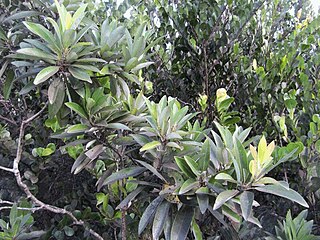
In botany, a drupe is an indehiscent type of fruit in which an outer fleshy part surrounds a single shell of hardened endocarp with a seed (kernel) inside. These fruits usually develop from a single carpel, and mostly from flowers with superior ovaries.

Laura Riding Jackson, best known as Laura Riding, was an American poet, critic, novelist, essayist and short story writer.

The avocado is a medium-sized, evergreen tree in the laurel family (Lauraceae). It is native to the Americas and was first domesticated in Mesoamerica more than 5,000 years ago. Then as now it was prized for its large and unusually oily fruit. The tree likely originated in the highlands bridging south-central Mexico and Guatemala. Its fruit, sometimes also referred to as an alligator pear or avocado pear, is botanically a large berry containing a single large seed. Sequencing of its genome showed that the evolution of avocados was shaped by polyploidy events and that commercial varieties have an hybrid origin. Avocado trees are partly self-pollinating, and are often propagated through grafting to maintain consistent fruit output. Avocados are presently cultivated in the tropical and Mediterranean climates of many countries. Mexico is the world's leading producer of avocados as of 2020, supplying nearly 30% of the global harvest in that year.

Persea is a genus of about 150 species of evergreen trees belonging to the laurel family, Lauraceae. The best-known member of the genus is the avocado, P. americana, widely cultivated in subtropical regions for its large, edible fruit.

Persea schiedeana, the coyo, is an endangered, evergreen tree in the laurel family (Lauraceae), native to tropical forests of southern Mexico and Central America. Its edible fruit resembles that of the avocado, a related tree in the genus Persea. Other common names include aguacate de montaña, aguacatón, chinini, chupte and yas.
Persin is a fungicidal toxin present in the avocado. Persin is an oil-soluble compound structurally similar to a fatty acid, a colourless oil, and it leaches into the body of the fruit from the seeds.
Kimberly Johnson is an American poet and Renaissance scholar.

Persea indica is a large, evergreen tree in the laurel family (Lauraceae), native to humid uplands on Madeira and the Canary Islands in the North Atlantic. It belongs to the genus Persea, a group of evergreen trees including the avocado. It is threatened by habitat loss.

Persea lingue, synonyms including Persea meyeniana, is an evergreen tree or shrub in the laurel family (Lauraceae), found in Argentina and Chile. It belongs to the genus Persea, a group of evergreen trees including the avocado. P. lingue was historically used in leather production, and is currently threatened by habitat loss.

Persea palustris, also known as swamp bay or swampbay, is a small tree or shrub found throughout the Southeastern United States and the Bahamas, with much of its range overlapping with that of its relative Persea borbonia. It is generally not more than 40 feet tall, with bark separated into scales by fissures across its surface. Mature leaves are green, paler on their undersides, which have prominent brownish or reddish-brown hairs. The species prefers swamps and coastal areas, particularly locations with moist, peat-rich soil. It is sensitive to the fungal disease known as laurel wilt, even more so than related species.

Sarah Gambito is an American poet and professor. She is the author of three collections of poetry, Loves You, Delivered, and Matadora. Her first collection, Matadora, was a New England/New York Award winner and won the 2005 Global Filipino Literary Award for Poetry.
Lisa Russ Spaar is a contemporary American poet, professor, and essayist. She is currently a professor of English and Creative Writing at the University of Virginia and the director of the Area Program in Poetry Writing. She is the author of numerous books of poetry, most recently Vanitas, Rough: Poems and Satin Cash: Poems. Her latest collection, Orexia, was published by Persea Books in 2017. Her poem, Temple Gaudete, published in IMAGE Journal, won a 2016 Pushcart Prize.

Savyon Liebrecht is an Israel author. She was born in Munich, Germany, to Polish Holocaust survivors as Sabine Sosnowski, the eldest of three children. She emigrated to Israel in 1950.

Persea borbonia or redbay is a small, evergreen tree in the laurel family (Lauraceae), native to the southeastern United States. It belongs to the genus Persea, a group of evergreen trees including bays and the avocado. Persea borbonia has several common names including tisswood, scrubbay, shorebay, and swampbay.

Melitaea persea is a butterfly of the family Nymphalidae. It is found from Iran and Asia Minor to Afghanistan and the western parts of the Tian Shan mountains.
Papyrus Oxyrhynchus 53 is a report on a persea tree, written in Greek. The manuscript was written on papyrus in the form of a sheet. It was discovered by Grenfell and Hunt in 1897 in Oxyrhynchus. The document was written on 25 February 316. It is housed in the British Museum. The text was published by Grenfell and Hunt in 1898.
The 'Lula' avocado is an avocado cultivar that originated in South Florida.

Persea macrantha, the large-flowered bay tree, is an evergreen tree in the laurel family (Lauraceae), native to southwestern India and Sri Lanka.

Patrick Rosal is a Filipino American poet and essayist.














